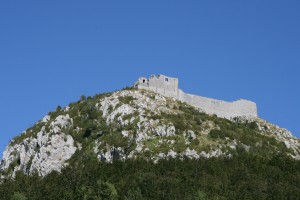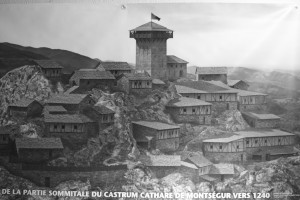Even though it’s been nearly 800 years since the massive fire at Montsegur when over 200 Cathars were exterminated at the hands of the Catholic Church, legends surrounding the Cathar Treasure remain. Through the years treasure seekers and speculators have included the holy crusaders who put siege to Montsegur’s fortress for nine months prior to the fire, the 1930’s amateur archaeologist, Otto Rahn (speculated to have provided the inspiration for Spielberg’s Indiana Jones), literary illuminati, esoteric explorers and even historical fiction writers. Many have searched; all have wondered.
In my previous post wherein I introduced the subject of this medieval religious sect, I noted their propensity for eschewing trappings of the mundane world. This rejection was based on their belief that the physical world and their incarnation in it was not a creation of God but rather a creation of Satan. In adopting this belief, the dedicated Cathars, known as Parfaits, not only rejected the idea of procreation, but they also did not partake in the consumption of any food which was a result of procreation. As material acquisitions for their own needs were kept to a bare minimum, it begs the question, ‘how did the legend of a Cathar Treasure arise’?
Among the various authoritative resources on the Cathars, author Zoe Oldenburg, tells us that by the end of the twelfth century, the Cathar movement of the Languedoc had amassed a considerable fortune. To begin with, the majority of Parfaits were men of substance who turned over their property to the church. In addition, there were also credentes, ‘rank and file’ members, who left legacies of their entire fortunes to the church. And, while living, many credentes made generous donations of cash, land, houses and even chateaux. While the Parfaits never broke their vow of poverty according to Oldenburg, they accepted all donations which were then put to the best use in the interests of the church.
As a Community, the Cathars were known for providing support to the poor and those in need in the cities and surrounding countryside. They maintained communes which incorporated schools, monasteries and hospitals. Furthermore they founded working craft guilds, particularly in the art of weaving which not only provided product but also functioned as an educational training ground for the young and ‘novitiates.’
While such amassing of property and goods certainly would be considered a ‘treasure,’ and references to ‘The Cathar Treasure’ often imply that it was something of far more importance and legend such as the Holy Grail… which of course has never been found. Speculative circumstances surrounding the Treasure’s disappearance often tell of it having been hidden some two months prior to the fiery execution. Possessing the secret of the Treasure’s hiding place, three Parfaits and another man, possibly a mountain guide, escaped the flames on the night of March 16 by repelling down the side of Montsegur’s pog. The men then hid in caves protecting the secret and were never discovered.
Oldenburg surmises that the Cathar cache consisted of goods for trading as well as gold and silver coins; this certainly makes sense given the atmosphere of persecution and brutality of the times. However, perhaps even more precious to the Cathars was that for them, the Treasure consisted of their most sacred books and writings which were critical in helping maintain allegiance to their dogma and tradition. This possibility makes even more sense as literature in the early middle ages onward, was considered as precious as gold in many cases. Whatever the truth is, to this day the location and substance of the Cathars’ Treasure remains a mystery. However, legends and myths die hard and certainly this one has much life left in it.
THE CURRENT REMAINS OF MONTSEGUR
RENDERING OF MONTSEGUR IN 1244 AT TIME OF THE FIRE
PHOTOGRAPHY©GAYE F. MACK, INC.
You can also follow me on:
https://www.facebook.com/gayemackauthor, https://www.twitter.com/gayemack, https://www.plus.google.com
https://www.linkedin.com, https://www.pinterest.com/gayemack5


